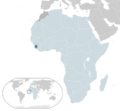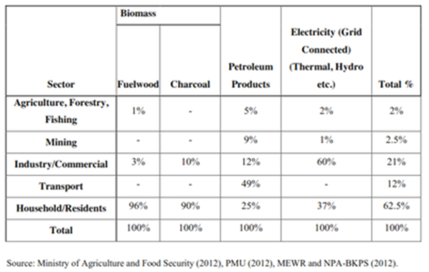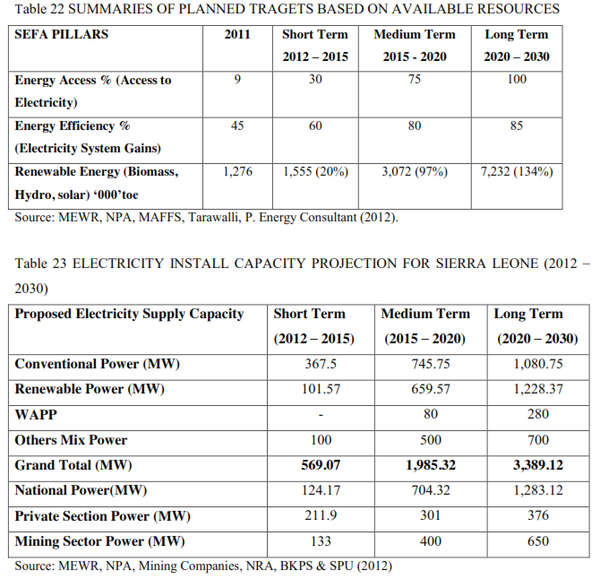Click here to register!
Difference between revisions of "Sierra Leone Energy Situation"
***** (***** | *****) |
***** (***** | *****) |
||
| Line 77: | Line 77: | ||
The bigger cities of Bo, Kenema and Makeni are also provided with hydro power. | The bigger cities of Bo, Kenema and Makeni are also provided with hydro power. | ||
| + | |||
| Line 83: | Line 84: | ||
In February 2017 Sierra Leone was the first African country to sign the "Energy Africa Policy Compact" with the Government of the UK. As part of the compact, the Energy Revolution initiative was launched, committing to reach 250.000 households with modern energy solutions by 2018. A task force was established and within government and private sector the focus shifted notably to renewable energy, especially solar energy. | In February 2017 Sierra Leone was the first African country to sign the "Energy Africa Policy Compact" with the Government of the UK. As part of the compact, the Energy Revolution initiative was launched, committing to reach 250.000 households with modern energy solutions by 2018. A task force was established and within government and private sector the focus shifted notably to renewable energy, especially solar energy. | ||
| − | According to the | + | According to the [http://www.irena.org/publications/2017/Jul/Renewable-Energy-Statistics-2017 “Renewable Energy Statistics 2017” report by IRENA], there is no solar power capacity installed in Sierra Leone. Nevertheless, in the last years some bigger projects have been implemented: |
| − | |||
| − | |||
| − | |||
Revision as of 10:20, 6 February 2018
Capital:
Freetown
Region:
Coordinates:
8.4844° N, 13.2344° W
Total Area (km²): It includes a country's total area, including areas under inland bodies of water and some coastal waterways.
72,300
Population: It is based on the de facto definition of population, which counts all residents regardless of legal status or citizenship--except for refugees not permanently settled in the country of asylum, who are generally considered part of the population of their country of origin.
8,605,718 (2022)
Rural Population (% of total population): It refers to people living in rural areas as defined by national statistical offices. It is calculated as the difference between total population and urban population.
56 (2022)
GDP (current US$): It is the sum of gross value added by all resident producers in the economy plus any product taxes and minus any subsidies not included in the value of the products. It is calculated without making deductions for depreciation of fabricated assets or for depletion and degradation of natural resources.
4,094,563,859 (2022)
GDP Per Capita (current US$): It is gross domestic product divided by midyear population
475.80 (2022)
Access to Electricity (% of population): It is the percentage of population with access to electricity.
27.49 (2021)
Energy Imports Net (% of energy use): It is estimated as energy use less production, both measured in oil equivalents. A negative value indicates that the country is a net exporter. Energy use refers to use of primary energy before transformation to other end-use fuels, which is equal to indigenous production plus imports and stock changes, minus exports and fuels supplied to ships and aircraft engaged in international transport.
no data
Fossil Fuel Energy Consumption (% of total): It comprises coal, oil, petroleum, and natural gas products.
no data
Introduction
Very few people have access to electricity in Sierra Leone: Approximately 10% to 12% of the urban population and only around 2% of the rural population. Petrol or diesel generators are often used because most of the region lacks a stable public power supply. Kerosene, battery lamps or candles are mainly used for lighting. 96,7% of the population cooks with firewood or charcoal. There is significant potential for the use of renewable energy, particularly solar energy and hydroelectric power.
Energy Situation / Statistics
“Energy statistics are difficult to obtain in Sierra Leone, especially for renewable energy. Although the conventional thermal energy production and consumption patterns have been reported, no consolidated set of statistics exists for the total Energy situation of Sierra Leone.[1]
This is also reflected in international reports, such as the “Renewable Energy Statistics 2017” report by IRENA, where the solar power capacity for Sierra Leone is claimed to be 0MW.
EnDev has signed a MoU to assist the Ministry of Energy in Sierra Leone with data collection, but information is difficult to obtain, since different private sector stakeholders are reluctant to share data.
Sierra Leone’s power sector is small, with less than 150 MW of operational capacity and roughly 150,000 connected customers.
The biggest grids are:
- The 161kv line that extends to Freetown and the surrounding Western Area , covering about 40% of their residents. The power is provided by the Bumbuna hydro power plant, situated aprox. 220km from Freetown.
- The Makeni grid, providing electricity to the town of Makeni in Port Loko District. The power is also provided by the Bumbuna hydro power plant.
- The 33kv electricity line, or Bo-Kenema, which provides electricity to the towns Bo and Kenema, the capitals of Bo and Kenema Districts in the southeast of the country.
The costs for electricity are highly subsidised by the Government and rate aprox. 1000 Leones (0,10 EUR) per kwh.
Overall Energy Use
- 80% Biomass (mainly for cooking): Wood and Charcoal
- 13% Petroleum products (mainly for transport, lighting and private energy generation, all petroleum is imported)
- Grid connected energy accounts for the remaining energy
- Most of the energy is used in households
Renewable Energy
“The country possesses vast potential in renewable energy in the form of biomass from agricultural wastes, hydro and solar power, which remain virtually untapped.”[2]
According to the “Renewable Energy Statistics 2017” report by IRENA there is a total capacity of 88 MW of Renewable Energy in the country, of which 56 MW are Hydro Power and 33 MW Bioenergy. However, as lined out above, data are incomplete. For example, Solar Energy is not included in the statistics.
Hydro Power
According to the “Renewable Energy Statistics 2017” report by IRENA, Sierra Leone has 56 MW hydro power capacity.
The biggest hydro power plant is situated in Bumbuna, at around 220km distance from Freetown in Tonkolili District, covering aprox. 40% of the capitals' residents. In wet season the Bumbuna hydro power plant generates aprox. 30-40MW and in the dry season 10-18MW, leading to frequent power blackouts in the months from February to April.
Nevertheless, the importance of the hydro power plant is reflected on the 5.000 Leones note, depicting the Bumbuna reservoir.
In the end of 2017, the parliament of Sierra Leone approved the so called "Bumunba II", an extension of Bumbuna I, adding a further 143MW of power capacity. [1]
The bigger cities of Bo, Kenema and Makeni are also provided with hydro power.
Solar Energy
In February 2017 Sierra Leone was the first African country to sign the "Energy Africa Policy Compact" with the Government of the UK. As part of the compact, the Energy Revolution initiative was launched, committing to reach 250.000 households with modern energy solutions by 2018. A task force was established and within government and private sector the focus shifted notably to renewable energy, especially solar energy.
According to the “Renewable Energy Statistics 2017” report by IRENA, there is no solar power capacity installed in Sierra Leone. Nevertheless, in the last years some bigger projects have been implemented:
Biomass
Biomass for Cooking
Fossil Fuel
Aprox. 33.3% of the energy in Sierra Leone comes from Fossile Fuels (44 MW from Oil)
Key Problems of the Energy Sector
- Financing/Investment
- Building up Infrastructure (Transmission and Distribution Networks)
- Many parts of the country have no grid access
- Network is very old (50 years) and many distribution lines were destroyed during the civil war
- This has led to large private sector generation, especially in industry. Many companies are forced to rely on diesel generators
- Generation capacity does not cover the demand
- Poor Energy Efficiency (both in terms of electricity generation and distribution as well as with biofuels/kerosene used for cooking and lighting)
- Old equipment
- No energy audits/benchmarking
- Inefficient cooking stoves + kerosene lights
Policy Framework, Laws and Regulations
“Improving the country’s energy sector is one of the Government’s foremost objectives …The Government is committed to working with the private sector, International Energy Development Programmes and the donor community to achieve these essential improvements.” [4]
Future Targets
Institutional Set up in the Energy Sector
Further Information
- A much more detailed report on the energy situation is provided in the National Energy Profile of Sierra Leone, published by the UN in 2012
- For a full overview of energy policies see: Sierra Leone Energy Africa Compact, published by Energy Africa
- Useful IRENA mapping tool for seeing the wind and solar potential in Sierra Leone
- A website on the Renewable Energy Sector in Sierra Leone was developped by EnDev and partners Renewables Salone.























